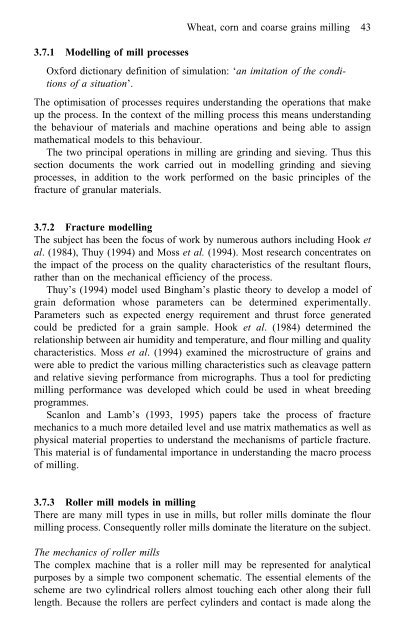Cereals processing technology
Cereals processing technology
Cereals processing technology
You also want an ePaper? Increase the reach of your titles
YUMPU automatically turns print PDFs into web optimized ePapers that Google loves.
Wheat, corn and coarse grains milling 43<br />
3.7.1 Modelling of mill processes<br />
Oxford dictionary definition of simulation: ‘an imitation of the conditions<br />
of a situation’.<br />
The optimisation of processes requires understanding the operations that make<br />
up the process. In the context of the milling process this means understanding<br />
the behaviour of materials and machine operations and being able to assign<br />
mathematical models to this behaviour.<br />
The two principal operations in milling are grinding and sieving. Thus this<br />
section documents the work carried out in modelling grinding and sieving<br />
processes, in addition to the work performed on the basic principles of the<br />
fracture of granular materials.<br />
3.7.2 Fracture modelling<br />
The subject has been the focus of work by numerous authors including Hook et<br />
al. (1984), Thuy (1994) and Moss et al. (1994). Most research concentrates on<br />
the impact of the process on the quality characteristics of the resultant flours,<br />
rather than on the mechanical efficiency of the process.<br />
Thuy’s (1994) model used Bingham’s plastic theory to develop a model of<br />
grain deformation whose parameters can be determined experimentally.<br />
Parameters such as expected energy requirement and thrust force generated<br />
could be predicted for a grain sample. Hook et al. (1984) determined the<br />
relationship between air humidity and temperature, and flour milling and quality<br />
characteristics. Moss et al. (1994) examined the microstructure of grains and<br />
were able to predict the various milling characteristics such as cleavage pattern<br />
and relative sieving performance from micrographs. Thus a tool for predicting<br />
milling performance was developed which could be used in wheat breeding<br />
programmes.<br />
Scanlon and Lamb’s (1993, 1995) papers take the process of fracture<br />
mechanics to a much more detailed level and use matrix mathematics as well as<br />
physical material properties to understand the mechanisms of particle fracture.<br />
This material is of fundamental importance in understanding the macro process<br />
of milling.<br />
3.7.3 Roller mill models in milling<br />
There are many mill types in use in mills, but roller mills dominate the flour<br />
milling process. Consequently roller mills dominate the literature on the subject.<br />
The mechanics of roller mills<br />
The complex machine that is a roller mill may be represented for analytical<br />
purposes by a simple two component schematic. The essential elements of the<br />
scheme are two cylindrical rollers almost touching each other along their full<br />
length. Because the rollers are perfect cylinders and contact is made along the



